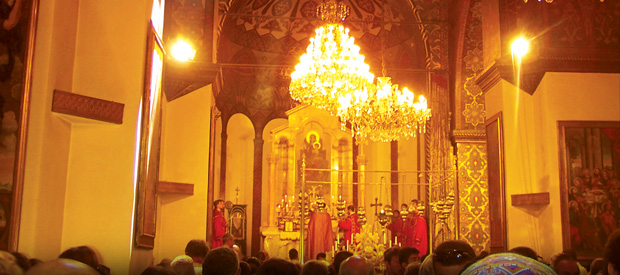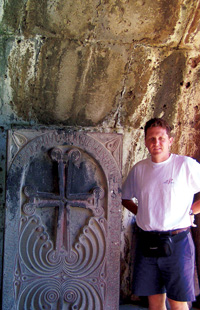There I was, in the little former Soviet Republic of Armenia, being asked by an Armenian Orthodox priest to lead a public prayer of blessing over the food.

“You know,” I said shyly, “Protestants pray very differently than Armenians.”
“Yes,” he replied, “but in our hearts we are all saying the same thing.”
Durin my trip to Armenia this summer, I was immersed into Armenian Christianity, the oldest state church in the world. Armenia became a Christian land in the year 301—decades prior to Constantine’s decision to embrace Christianity in the Roman Empire.

I became interested in Armenian Christianity during my doctoral studies several years ago. I was fascinated by this small Christian kingdom that had remained faithful to its Christian heritage despite terrible waves of persecution: Persian and Arab invasions, the Armenian genocide commited by Turks in 1915, and the Soviet era. Their resilient faith is evident today, both in Armenia, as well as in the large diaspora of Armenians all over the world, particularly in Southern California. Glendale, Burbank, Fresno, and Pasadena all have considerable Armenian communities. There is even a “Little Armenia” in east Hollywood.
Christianity is at the very heart of Armenian identity. Even if people do not attend church regularly, being Armenian is almost coterminous with a Christian identity. I set out to investigate these issues this past summer. I met with Levon Goukasian, an Armenian professor of finance at Pepperdine, and we hatched up a plan to do some research. We recruited Mike Sugimoto, a specialist in identity formation and fellow Pepperdine professor. Each of us was allowed to hire a student assistant as part of the CDIUR (Cross-Disciplinary/Interdisciplinary Undergraduate Research) program. Our research project involves interviews and surveys and is primarily concerned with how Armenia has maintained its Christian identity in the face of incredible odds.
I had so many rare learning experiences that I will be able to share with students in my church history courses:
- Worshipping God in a church built in the year 430
- Hearing angelic, haunting a cappella liturgies which hearken back to the first centuries of the Christian faith
- Discussing the Armenian genocide with people whose lives have been indelibly impacted by the 20th century’s first holocaust
- Crawling down into the cave where St. Gregory the Illuminator was imprisoned for over a decade and emerged to become the founder of Christianity in Armenia
- Drinking from a spring inside the sanctuary of Geghard—a spectacular church and labyrinthine monastic compound built into cliff walls in the 12th and 13th centuries
- Eating lavash (Armenian flatbread) fresh out of the tandoor oven, wrapped around fresh goat meat and herbs, along with the Armenian national fruit—apricots—known affectionately in Armenia as tsiran. (Interestingly, the scientific name for the apricot is Prunus armeniaca—as they grow ubiquitously in Armenia.)
I did not know Professor Goukasian until fairly recently. A colleague informed me that we have an Armenian professor at Pepperdine, and I thought he might be able to connect me with people in his homeland. One day I phoned him up, hoping to meet with him. Come to find out, we live about three doors from each other and did not even know it. We were easily able to meet and get acquainted.
Meeting Professor Goukasian was one of the greatest things that could have happened in preparation for my trip to Armenia. He put me into contact with Father Avedis, that priest who graciously asked me to pray over a meal in what Armenians call “the Motherland.” Avedis invited me to take part in the CYMA program—the Christian Youth Mission to Armenia. CYMA is a program run by the Western Diocese of the Armenian Church, intended to immerse Armenians into their culture, particularly their religion. Each summer the CYMA program sponsors a group of young adults from the Armenian Church as they participate in a religious pilgrimage to their ancestral homeland.
This proved to be an exceptional opportunity: I was able to live in a house with Armenians; I became friends with Avedis and spent hours upon hours talking with him about Armenian culture; I toured Armenian historical and religious sites within a reverent context of pilgrimage; and our small group even met the Armenian Catholicos—Armenia’s version of the Pope—in a private audience at the Mother See of Holy Etchmiadzin.
I will never forget this trip: the summer I was able to see, firsthand, the oldest Christian country in the world. I had so many rare learning experiences that I will be able to share with students in my church history courses (see sidebar).
There are few honors as high as being welcomed by another group of people into their homes and into their lives. Rarer still is when a group of Christians from a very different milieu welcome another to pray with them, around the dinner table, in thanks to God for our food. On the night before I departed Armenia, I was asked to give a toast since it was my last night to be with them. I offered two words: “To gratefulness.”
